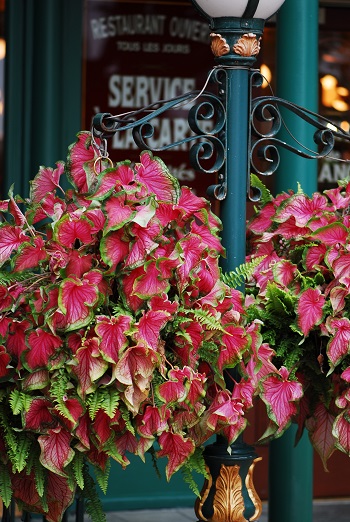
Caladiums are tuber-rooted tropical perennials grown for their large and showy leaves. Caladiums have no stems; the leaves are borne on long, 6-12 inches, petioles (leaf stems) that arise directly from the underground tuber. The petioles are attached to the leaves near the center, rather than at one end, a condition called peltate. Leaf shape, size and color vary among the hundreds of selections, but most are heart; lance or arrowhead shaped, 6-14 inches long, and variously spotted or streaked with pink, red, gray, or white. The caladium inflorescence is a 9-inch greenish white Jack-in-the-pulpit-like spadix and spathe. (The spadix is the fleshy upright spike with tiny flowers on it – Jack; and the spathe is the hood-like bract that surrounds the spadix – the pulpit.) Small white berries eventually develop on the spadix. The entire plant, by the end of its growing season, is about 2 feet tall and 2 feet wide.
Location
The many cultivars of caladium (at least 1,000 have been named!) were developed from the wild Caladium bicolor that grows naturally in tropical South American forests that have pronounced wet and dry seasons.
Culture
Outdoors, caladiums should be planted in well drained, humus rich soil with a slightly acid pH. Work some partially rotted leaves into regular garden soil but do not add lime. Successful gardeners dig the tubers in autumn and store in a cool 55-60º F, dry place until replanting 4-5 months later when spring arrives. You can leave the tubers in the container for potted caladiums but withhold water during the winter dormant period.
Light
Most cultivars require partial to full shade, but some newer sun-tolerant caladiums are now available.
Moisture
Caladiums need lots of water during their growing season so water them 2 or 3 times a week. They do poorly in dry climates. The dormant tubers, however, must be kept dry.
Hardiness
Caladiums are popular garden plants in most zones but survive the winters only in Zones 9 – 12. Plant tubers in the spring when there is no danger of frost. Dig up the tubers for their 4–5-month winter rest period when the leaves begin to fade in autumn. In zones 10B-12, caladiums can be left in the ground all winter, but they may rot if it rains a lot.
Propagation
Caladiums are propagated by division of the tubers. Tubers should be cut into pieces with at least two buds (“eyes”) each in spring, at the end of the dormant period just before they are replanted. Some gardeners dust the cut ends with a fungicide before setting them out. Set the tubers only about an inch deep. Caladiums also can be grown from seed, but these may or may not produce plants like the parent.
Usage
Caladiums are used in shady beds and borders. They often are planted along the north or east side of a building or wall. Caladiums are striking in dense plantings. They provide warm color in areas too shady for most flowers. Use caladiums to provide some color amongst lacy ferns and stately gingers. Caladiums also are grown in containers and in the greenhouse. Indoor caladiums should be misted daily or even more often and given bright light, but never direct sun. Caladium leaves will last for several days in fresh flower arrangements.
Related Articles & Free Email Newsletter Sign Up
Cacti are a Great Plant for Your Greenhouse
Plant Profile – Bamboo Orchid Combines the Best of Bamboo and Orchids
Plant Profile – Bismarck Palm is an Extraordinary Palm with Huge Leaves



Comment here